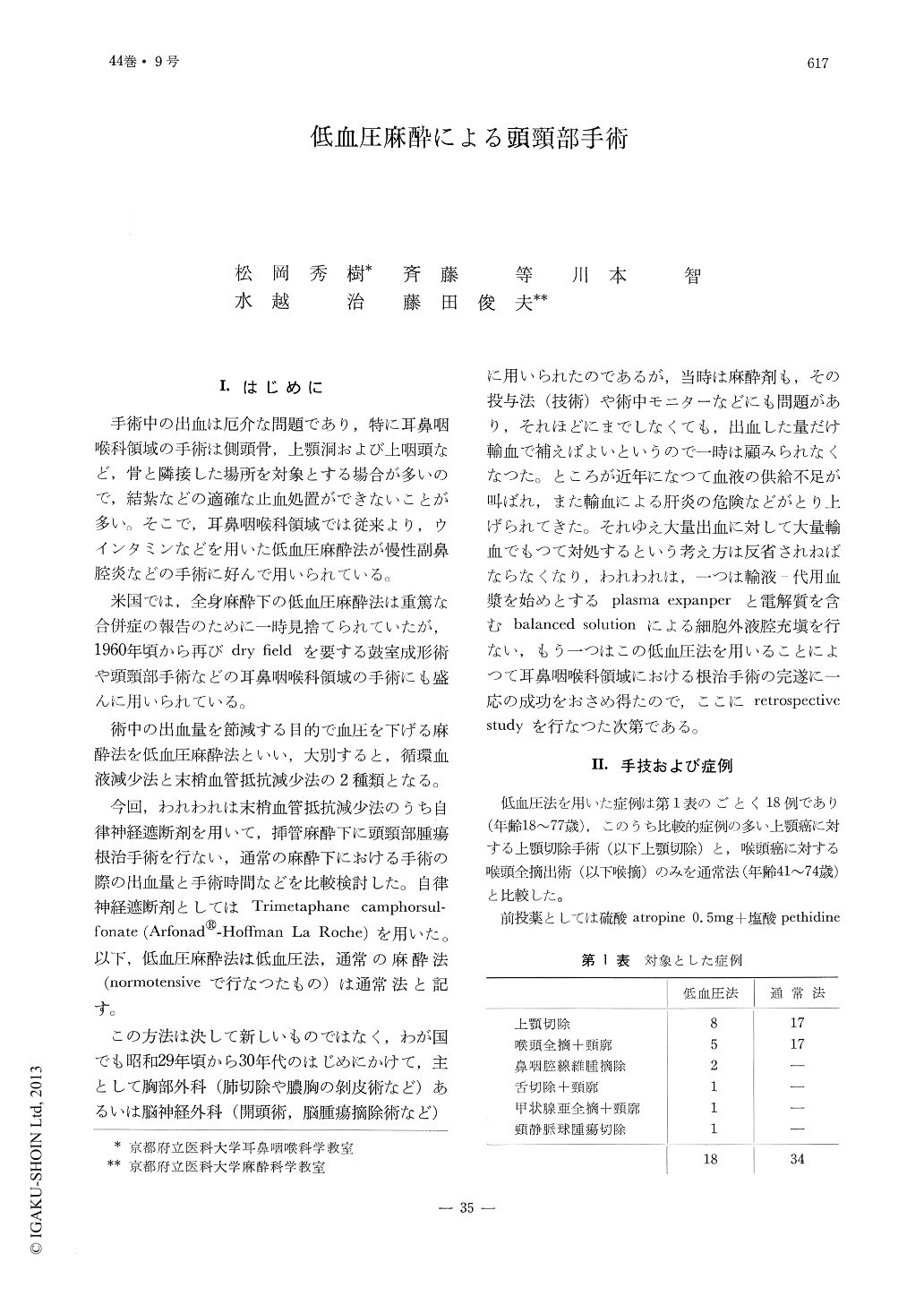Japanese
English
- 有料閲覧
- Abstract 文献概要
- 1ページ目 Look Inside
I.はじめに
手術中の出血は厄介な問題であり,特に耳鼻咽喉科領域の手術は側頭骨,上顎洞および上咽頭など,骨と隣接した場所を対象とする場合が多いので,結紮などの適確な止血処置ができないことが多い。そこで,耳鼻咽喉科領域では従来より,ウインタミンなどを用いた低血圧麻酔法が慢性副鼻腔炎などの手術に好んで用いられている。
米国では,全身麻酔下の低血圧麻酔法は重篤な合併症の報告のために一時見捨てられていたが,1960年頃から再びdry fieldを要する鼓室成形術や頭頸部手術などの耳鼻咽喉科領域の手術にも盛んに用いられている。
術中の出血量を節減する目的で血圧を下げる麻酔法を低血圧麻酔法といい,大別すると,循環血液減少法と末梢血管抵抗減少法の2種類となる。
今回,われわれは末梢血管抵抗減少法のうち自律神経遮断剤を用いて,挿管麻酔下に頭頸部腫瘍根治手術を行ない,通常の麻酔下における手術の際の出血量と手術時間などを比較検討した。自律神経遮断剤としてはTrimetaphane camphorsulfonate(Arfonad®-Hoffman La Roche)を用いた。以下,低血圧麻酔法は低血圧法,通常の麻酔法(normotensiveで行なつたもの)は通常法と記す。
この方法は決して新しいものではなく,わが国でも昭和29年頃から30年代のはじめにかけて,主として胸部外科(肺切除や膿胸の剥皮術など)あるいは脳神経外科(開頭術,脳腫瘍摘除術など)に用いられたのであるが,当時は麻酔剤も,その投与法(技術)や術中モニターなどにも問題があり,それほどにまでしなくても,出血した量だけ輸血で補えばよいというので一時は顧みられなくなつた。ところが近年になつて血液の供給不足が叫ばれ,また輸血による肝炎の危険などがとり上げられてきた。それゆえ大量出血に対して大量輸血でもつて対処するという考え方は反省されねばならなくなり,われわれは,一つは輸液-代用血漿を始めとするplasma expanperと電解質を含むbalanced solutionによる細胞外液腔充填を行ない,もう一つはこの低血圧法を用いることによつて耳鼻咽喉科領域における根治手術の完遂に一応の成功をおさめ得たので,ここにretrospective studyを行なつた次第である。
Since bleeding in otolaryngological surgery is often met with in structures adhering to bony tissues such as temporal and maxillary bones and the nasopharynx, its conyrol is at times quite difficult.
In order to decrease the amount of blood losses in such cases, hypotensive anesthesia was introduced with use of trimetaphane (Arfonad) which was capable or maintaining the systolic blood pressure at approximately 80 mmHg. Eighteen cases of operations in the head and neck region were performed under this method.
Out of 18 cases, 8 cases of maxillary operation and 5 cases of laryngectomy with extensive neck resections showed a remarkable reduction in blood losses during the procedure which was capable of maintaining a dry field of operation. There were no postoperative complications in this series.

Copyright © 1972, Igaku-Shoin Ltd. All rights reserved.


